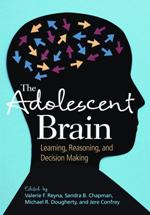By Karene Booker
Reprinted from Cornell Chronicle, December 15, 2011

Teenage brains undergo big changes, and they won't look or function like adult brains until well into one's 20s. In the first book on the adolescent brain and development of higher cognition, a Cornell professor helps highlight recent neuroscience discoveries about how the brain develops and their implications for real-world problems and how we teach young people and prepare them to make healthy life choices.
For the new book, "The Adolescent Brain: Learning, Reasoning, and Decision Making" (APA Books), Valerie Reyna, professor of human development in the College of Human Ecology and co-director of Cornell's Center for Behavioral Economics and Decision Research, brought together an interdisciplinary group of leading scientists to focus on brain development and higher cognition, which is necessary for students to learn math and science and make good decisions. Higher cognition is the set of thinking skills students use to manipulate information and ideas in ways that lead to problem solving and new insights.
 "A major implication of the provocative research highlighted in this book is the contrast between adolescents' cognitive skills, which are at a lifetime peak, and their frequent inability to use this competence in everyday decision making," said Reyna, who co-edited the volume with Sandra Chapman, director of the Center for Brain Health at the University of Texas at Dallas; Michael Dougherty, professor of psychology at University of Maryland; and Jere Confrey, professor of mathematics education at North Carolina State University.
"A major implication of the provocative research highlighted in this book is the contrast between adolescents' cognitive skills, which are at a lifetime peak, and their frequent inability to use this competence in everyday decision making," said Reyna, who co-edited the volume with Sandra Chapman, director of the Center for Brain Health at the University of Texas at Dallas; Michael Dougherty, professor of psychology at University of Maryland; and Jere Confrey, professor of mathematics education at North Carolina State University.
"But the evidence suggests that the way young people learn, reason and decide changes [during this period] and can be changed," said Reyna. "We must move education beyond rote learning to fostering the cognitive skills essential for academic achievement and economic well-being in our knowledge-based economy. Higher cognition is a foundation critical for individuals and our country to be competitive. This volume introduces a new framework for interdisciplinary collaboration among scientists in neuroscience, psychology and education."
"The Adolescent Brain" addresses the major changes in memory, learning and decision making experienced by adolescents as they mature, beginning with a review of the changes in brain anatomy and physiology based on extensive neuroimaging studies. The ensuing chapters examine the developing capacity of the adolescent brain, covering such topics as the underpinnings of intelligence and problem solving, strategies for training teen reasoning abilities, effectively teaching mathematical concepts, the effects of emotion on reasoning, and factors that promote teen engagement in health-related behaviors.
The book wraps up with a chapter by Reyna and Ph.D. student Christina Chick that integrates the behavioral and neuroscience evidence in a process model of adolescent risky decision making. Chick and Reyna explain, for example, how massive pruning of gray matter in late adolescence fits with the growth of adolescents' ability to connect the dots and understand the underlying meaning of situations. This gist thinking facilitates recognition of danger and protects against unhealthy risk-taking, they say.
The book is intended for researchers, students and professionals in the fields of cognitive neuroscience and psychology and for education policymakers and educators, especially in mathematics.
Reyna will present a talk on the "Adolescent Brain" March 1 at 4-5:30 p.m., 160 Mann Library.
Karene Booker is extension support specialist in the Department of Human Development.

